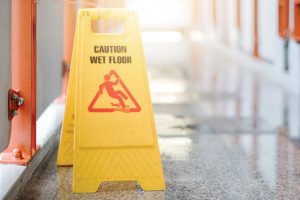— By Maia McNair —
Time for a floor care overhaul before winter sets in.
With winter right around the corner, facility managers must have a sound floor care strategy in place to keep surfaces looking their best, protect customers and reduce long term maintenance and replacement costs.
Winter Woes

Maia McNair, Diversey
Used to improve traction in store parking lots and prevent outdoor slip-and-falls, salt and sand easily make their way indoors during the winter. These de-icing materials can wear away floor finishes and surfaces if they are not regularly removed. Additionally, rock salt can cause excess water to pool and may erode the floor wax. Combined with snow that melts inside, floors can become covered in dangerous and unsightly puddles if their care is not well managed.
Falls are not only common in workplace settings, but costly. According to the Liberty Mutual 2018 Workplace Safety Index, falls on the same level, such as slipping on a wet floor, cost businesses $11.2 billion per year. Meanwhile, injuries resulting from tripping or slipping without a fall cost an additional $2.3 billion.1
In addition to salt, sand and snow, asphalt can also negatively impact the look and lifespan of floors. When removing snow from roads and parking lots, plows may unknowingly break up the top layer of asphalt. These small particles can become trapped in shoe soles and then dislodge onto floors.
A Range of Flooring Types
Retailers install various types of flooring throughout stores, including vinyl composition tile (VCT), concrete and carpet. VCT is a fairly cost-effective type of flooring that can also withstand the heavy foot traffic that retailers experience on a daily basis. However, VCT that is not properly sealed can gradually be worn down by sidewalk salt, and mold can build up when moisture is present.
Concrete is increasingly being utilized in retail settings due to its resilience. However, restoring concrete floors can be challenging and costly if they have not been cared for properly. Winter salts can be especially harsh on polished concrete, breaking down the bonds of the surface and resulting in stains.
Finally, some retailers opt for the warmth of carpet throughout their stores or in various areas such as clothing departments. While carpet traps dust and allergens so that they can later be vacuumed, winter contaminants can impact the appearance of carpet, accelerate fiber deterioration and cause mold to build up.
Floor Care Best Practices
 Retail store managers should consider the following best practices to keep floors clean and safe during the winter season.
Retail store managers should consider the following best practices to keep floors clean and safe during the winter season.
- Invest in matting: Matting is your facility’s first defense against the outdoor elements. Scraping mats with blades in alternating directions work to dislodge material from shoe soles as employees and patrons enter the building and also capture moisture that can lead to slip-and-fall hazards and damage to floors. Place these mats at all entrances, with 9 to 15 feet of matting laid down to account for several footsteps before guests reach exposed floor surfaces. In addition to absorbing moisture, mats should also be able to hold liquid to prevent it from leaking onto floors and creating puddles. Select mats with a rubber backing to prevent them from slipping across floors and regularly extract water with a wet/dry vacuum to remove excess moisture.
- Harness the power of diamonds: The right floor pads can make all the difference when it comes to floor care. Today, floor pads with billions of microscopic diamonds can clean and polish floors at the same time, saving employees time while improving the appearance of substrates like tile and concrete. These pads can also accomplish impressive results without the use of chemicals, using just water to remove contaminants and restore the look of floors.
- Find the right machine for your needs: There are numerous types of floor care machines, from ride-on to walk-behind to robotic. Whichever type you invest in, select a machine with an appropriate working width to quickly clean, and a durable squeegee with excellent water pickup to fully remove water from floors. The machine should also feature a large tank to reduce the need for time-consuming refills.
- Train employees: Retailers face high staff turnover, so it’s possible that some employees have yet to tackle floor care during the winter. During the fall months, retailers should train employees on proper floor care processes. Employees should regularly use a wet/dry vacuum for large particles and for carpet. Daily cleaning of tile and concrete with diamond pads helps reduce or even eliminate periodic maintenance while also reducing the lifecycle costs of flooring.
Making Customers Feel Welcome
 Properly maintained floors communicate that your business values cleanliness, safety and the overall customer experience. However, floors are continually put to the test, especially during winter. In some areas of the country, winter can stretch for 6 months. It’s important for stores to follow proper floor care procedures to keep contaminants like snow, salt and sand from negatively impacting customer satisfaction and safety. Consistent and well-planned floor care can also prevent labor and floor care costs from skyrocketing and ultimately extend the lifespan of floors.
Properly maintained floors communicate that your business values cleanliness, safety and the overall customer experience. However, floors are continually put to the test, especially during winter. In some areas of the country, winter can stretch for 6 months. It’s important for stores to follow proper floor care procedures to keep contaminants like snow, salt and sand from negatively impacting customer satisfaction and safety. Consistent and well-planned floor care can also prevent labor and floor care costs from skyrocketing and ultimately extend the lifespan of floors.
1 https://viewpoint.libertymutualgroup.com/article/2018-workplace-safety-index/
— Maia McNair is the North American retail sector marketing director with Diversey, a leader in providing smart, sustainable solutions for cleaning and hygiene, such as TASKI® Twister diamond pads. For more information, email [email protected] or visit www.diversey.com/industry-sectors/retail.
